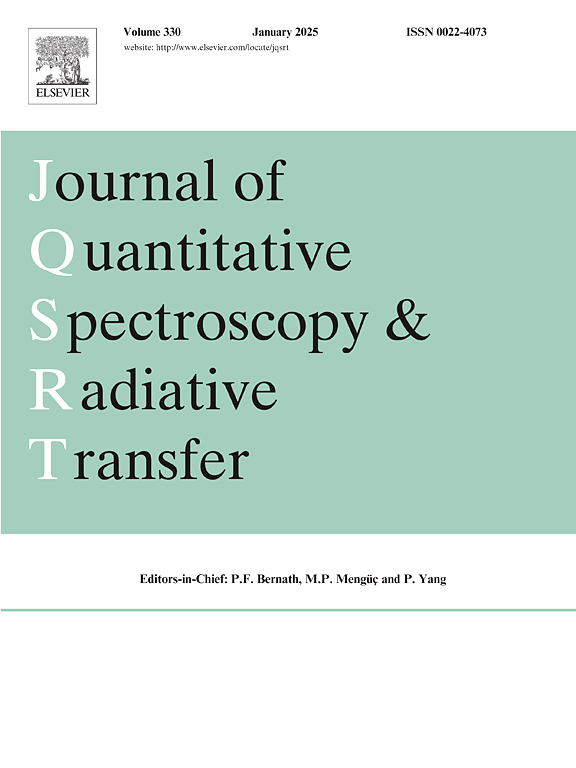通过激光诱导电离制备氪原子的机制
IF 2.3
3区 物理与天体物理
Q2 OPTICS
Journal of Quantitative Spectroscopy & Radiative Transfer
Pub Date : 2024-10-31
DOI:10.1016/j.jqsrt.2024.109233
引用次数: 0
摘要
通过激光诱导电离,制备出了 5s[3/2]2 水平的可转移 Kr 原子。利用波长分别为 760.15 nm、811.29 nm 和 431.96 nm 的 Kr 原子光谱线强度的时间演变来阐明可陨落 Kr 原子的产生机制。这些机制主要涉及两个过程:以多光子激发和初始等离子体诱导的电子撞击激发为主的 "激发+辐射 "过程和以雪崩电离为主的 "离子-电子重组 "过程。实验获得了在强电离和弱电离条件下分别与 "激发+辐射 "和 "离子-电子重组 "过程相对应的 Kr 原子谱线的衰变时间常数。实验结果表明,在这两个过程之间,陨变 Kr 原子的制备出现了延迟。为了减少 "陨落 "Kr 原子的损耗并有效利用其峰值浓度,我们从 "陨落 "稀有气体激光中得到启发,提出了 "循环 "的设想,使这两个过程产生的 "陨落 "Kr 原子尽可能保持同步。我们使用 811.29 nm 激光将在 "激发 + 辐射 "阶段快速产生的畸变 Kr 原子激发到 5p[5/2]3 水平。这些 Kr 原子通过自发辐射回到 5s[3/2]2 水平,与在 "离子-电子重组 "阶段缓慢产生的可转移 Kr 原子合并。我们希望 "循环 "的想法能缩短这两个过程制备可迁移 Kr 原子的延迟时间,并提高可迁移 Kr 原子的峰值浓度。然而,实验结果并没有达到预期,我们观察到激光激发后 811.29 nm 的荧光有所减弱,这归因于 5p[5/2]3 水平 Kr 原子的积累。这些原子经过能量汇集,填充到 4d'[3/2]1 和 5d[7/2]3 水平,然后吸收 811.29 纳米激光能量,导致光离子化。降低 5p[5/2]3 水平 Kr 原子的浓度有助于缓解再电离问题。本文章由计算机程序翻译,如有差异,请以英文原文为准。
Mechanism of metastable krypton atom preparation via laser-induced ionization
Preparation of metastable Kr atoms in the 5s[3/2]2 level via laser-induced ionization has been achieved. The temporal evolution of the intensity of Kr atomic spectral lines at 760.15 nm, 811.29 nm, and 431.96 nm was used to elucidate the production mechanisms of metastable Kr atoms. These mechanisms primarily involve two processes: the “excitation + radiation” process, dominated by multiphoton excitation and initial plasma-induced electron impact excitation, and the “ion-electron recombination” process, governed by avalanche ionization. The decay time constants of Kr atomic spectral lines, corresponding to the “excitation + radiation” and “ion-electron recombination” processes respectively, were obtained experimentally under both strong and weak ionization conditions. The experiments revealed delay in preparations of metastable Kr atoms between these two processes. To reduce the loss of metastable Kr atoms and effectively utilize their peak concentration, we drew inspiration from metastable rare gas lasers and proposed the “cycling” idea to keep metastable Kr atoms produced by these two processes as synchronized as possible. We used 811.29 nm laser to excite metastable Kr atoms generated rapidly during the “excitation + radiation” stage to the 5p[5/2]3 level. The Kr atoms returned to the 5s[3/2]2 level through spontaneous radiation, merging with metastable Kr atoms that were slowly produced during the “ion-electron recombination” stage. We hope that the “cycling” idea can shorten the delay in preparations of metastable Kr atoms from both processes and enhance the peak concentration of metastable Kr atoms. However, the experimental results didn't meet expectations, as we observed a decrease in the 811.29 nm fluorescence after laser excitation, attributed to the accumulation of 5p[5/2]3 level Kr atoms. These atoms undergo energy pooling to populate the 4d’[3/2]1 and 5d[7/2]3 levels, followed by absorption of 811.29 nm laser energy leading to photoionization. Reducing the concentration of 5p[5/2]3 level Kr atoms helps mitigate the reionization issue.
求助全文
通过发布文献求助,成功后即可免费获取论文全文。
去求助
来源期刊
CiteScore
5.30
自引率
21.70%
发文量
273
审稿时长
58 days
期刊介绍:
Papers with the following subject areas are suitable for publication in the Journal of Quantitative Spectroscopy and Radiative Transfer:
- Theoretical and experimental aspects of the spectra of atoms, molecules, ions, and plasmas.
- Spectral lineshape studies including models and computational algorithms.
- Atmospheric spectroscopy.
- Theoretical and experimental aspects of light scattering.
- Application of light scattering in particle characterization and remote sensing.
- Application of light scattering in biological sciences and medicine.
- Radiative transfer in absorbing, emitting, and scattering media.
- Radiative transfer in stochastic media.

 求助内容:
求助内容: 应助结果提醒方式:
应助结果提醒方式:


